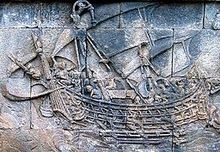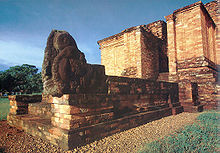Srivijaya
Srivijaya ( Sanskrit Śrīvijaya "radiant victory", also Sri Vijaya, Sriwijaya or Shri Vijaya ) was a Buddhist thalassocracy in Southeast Asia . The center of Srivijaya was on Sumatra , but his area of influence also included the coastal areas of the Malay Peninsula and West Java . Its predominance in the region lasted from the end of the 7th to the end of the 13th century.
Basics

This state was only discovered for modern historiography in 1918, when the French historian George Coedès interpreted the name Srivijaya and identified it with the Sribuza and Sarbaya of the Arabic and the Sanfoqi of the Chinese sources.
The capital is equated with today's Palembang on Sumatra, ie it is probably buried underneath (the discovery of a large Ganesha statue serves as an indication ). Its network of monasteries, (partly public) parks, markets and ports was delimited by the river system of the Musi , the holy mountain of Srivijaya was probably the Bukit Seguntang.
Srivijaya was founded around 500, perhaps instead of Kan-t'o-li or another predecessor state. A century later, Chinese sources spoke of two kingdoms in Sumatra: one in Jambi and one in Palembang, with Jambi perhaps the more important kingdom as it was more closely related to China. Jambi was taken over by Srivijaya as early as 686, of which the pilgrim monk Yi Jing bears witness.
The rise of the state was due to the favorable location of Palembang as a port or transhipment point (fabrics, jewels, ivory, elephants, raw silver, amber , camphor , spices, precious woods) between the Strait of Malacca and the Sunda Strait . With the monsoon ships came from China, India and Arabia, so that one speaks of the silk road of the sea . Favorable relationships with China were important here, so that the ships were not detained, taken advantage of or even robbed in Canton , if possible .
Peak of power
Srivijaya expanded its sphere of influence from the middle of the 7th century. Between 683 and 686, it made its influence felt on the Sunda Strait and in West Java under King Jayanasa . Of great importance was the support of the indigenous Indonesian population, who operated piracy under the name Orang Laut (seafarers) , but also provided the backbone of the fleet with appropriate treatment.
Between 702 and 724, Srivijaya sent four embassies to Tang China . By 775 it had extended its dominion to the Malay Peninsula and occupied 14 city-states. At that time it could have controlled both the Malacca Straits and the Sunda Straits. But the Javanese , with the pirate king Sanjaya (around 730) at the helm, were dangerous opponents. Peace was not reached until 775. Mutual relations with the Sailendra kings of Java, who had just come to power, were established and they were strengthened by marriage. Around 850 even a displaced Sailendra prince named Balaputra was able to take over the government in Srivijaya because his mother was from there.
Since Srivijaya owed its wealth to trade, it also came to terms with Song China and formally recognized its emperor as overlords. In 905 even a King Srivijaya himself could have appeared at court - the visitor was given the title "General who pacifies foreign countries". In any case, the Maharaja / King Chulamanivarmadeva requested Chinese support against the Javanese unsuccessfully in 992 when both states got back into a state of war over religious and commercial issues (990-1006). Srivijaya triumphed with the conquest of the enemy capital and in 1030 King Sangrama Vijayottungavarman consolidated the peace with a marriage.
Culture and state

Culturally, the kingdom was dominated by Buddhism, even after this was already supplanted by Hinduism in India and neighboring Java . The Chinese pilgrim monk Yì Jìng visited it on his journey to / from India (671/695). There he found no fewer than 1,000 scholars of international origin and an excellent library and a Buddhist center that was in constant contact with Nalanda . King Balaputra even made foundations there to legitimize himself. However, one shouldn't overestimate the Indian influence. The lingua franca was probably Malay , with Sanskrit interspersed .
In addition to the already described trade and the associated trade taxes, Srivijaya also relied on the production of luxury and consumer goods, especially nipa mats, tortoiseshell, beeswax, aromatic woods and camphor . When collecting the natural products, the services of the indigenous Indonesian people called Orang Asli (forest dwellers) were also used.
The Indian heritage shaped the laws, politics and religion of the state of Srivijaya, even if it was also exposed to Chinese and later Islamic influences in the course of trade. As in India, the state structure resembled a pyramid of princes with a system of dependencies or loyalty relationships. If a small state was affiliated, it retained its free trade, but had to pay tribute, enter into marriages and forego its own embassies ( mandala model ).
According to the Southeast Asian mandala model, the state (or states) of Srivijayas was built in concentric circles (not only from a spatial, but also from a social perspective). In the center was the kedatuan , the residence of the Datu (prince) and his court. The kedatuan was surrounded by vanua , a semi-urban area in which other officials lived, but which also included villages, markets and a temple. Kedatuan and vanua together made up the city of Srivijaya. This was surrounded by samaryyada , the other areas controlled by the Datu. The outermost circle of the system was formed by the autonomous or semi-autonomous communities on the edge of Srivijaya's sphere of influence. These could either be ruled by a Datu recognized by the ruler of Srivijaya or by one appointed by Srivijaya. The principalities of the first group themselves had a concentric mandala structure. The larger or the further away from the center they were, the greater their autonomy and the more likely it was that they could break away from Srivijaya.
The ties between the units in the network were based on oaths of loyalty (comparable to the feudal oath ) and the granting of royal favors and blessings by the overlord in return for tributes in the form of goods or services. The Datu based its rule on huluntuhan (literally "servant-masters"), a term that is translated as "empire", but can also mean the Datu's family or a network of family members and vassals. 'Datu' was also used in Srivijaya not only for the person of the prince, but in a broader sense also for his rule, his relatives and representatives appointed by him. The Datu were considered sacred and inviolable, and supernatural powers were ascribed to them. Among other things, the Datu was made responsible for the fertility of the land.
Decay and Fall
The loose state structure turned out to be a disadvantage when conquerors came from southern India with the Chola kings in the 11th century . The Chola attacked Srivijaya in 1017, 1025 and 1068 with their newly created fleet and were able to bind some territories to themselves, although they never seemed to want permanent rule, but rather to eliminate trade competition. In any case, the attack by Chola king Rajendra I in 1025 was a shock - 14 ports were looted and trade with China stalled for a few years, so that the Chinese authorities even had to ask for the trade.
From then on, the decline of Srivijaya began, which disintegrated under the influence of independence movements and piracy. This can be seen from the fact that dependent kings like those of Kedah, Malayu or Jambi and Kampe sent their own embassies. In the 12th century, the kings of Jambi on Sumatra - and no longer those in neighboring Palembang - represented the Lords of Srivijayas. Another factor of decline was apparently the increase in Chinese shipping during the Song era , which competed with the Malay middlemen or Srivijaya made. Even so, Srivijaya still had 15 vassals in the early 13th century.
The King of Singhasari on Java, Kertanagra (ruled 1268–1292) conquered or took over a large part of today's Indonesia around 1275–90, thereby ending the supremacy of Srivijaya. The kingdom was under Javanese suzerainty in the following century , but did not finally end until 1377 when the troops of Majapahit conquered Palembang. Perhaps it lasted a little longer because a rebellious prince from Srivijaya accepted Islam in 1414 and founded Malacca .
The famous kings up to the 11th century
- 682/95 Jaya-nasa
- 702/24 Sri Indra-varman
- 728/42 Rudra Vikkama
- approx. 775 Dharmasetu
- 832-60 Balaputra deva
- 960/62 Sri Udayaditya
- 980/83 Haji
- 1003/05 Sri Culamani Varma-deva
- 1017 Haji Sumatra bhumi
- 1024/30 Sri Sangramu Vijayottunga-varman
- 1064 Dharmavira
literature
- George Coedès , Louis-Charles Damais: Sriwijaya - History, Religion & Language of an early Malay polity. Collected studies. Malaysian Branch, Royal Asiatic Society, Kuala Lumpur 1992.
- Geoffrey C. Gunn: History Without Borders. The Making of an Asian World Region, 1000-1800. Hong Kong University Press, 2011. Chapter "Rise and Fall of the Southeast Asian 'Charter' Kingdoms", pp. 51-78
- Kenneth R. Hall: Economic History of Early Southeast Asia. In: The Cambridge History of Southeast Asia Volume 1, Cambridge University Press, 1992, pp. 183-275.
- Kenneth R. Hall: A History of Early Southeast Asia. Maritime Trade and Societal Development, 100-1500. Rowman & Littlefield, Lanham MD / Plymouth 2011. Chapter “The Foundations of Indonesian Polity. Srivijaya and Java to the Early Tenth Century, "pp. 103-134.
- Michel Jacq-Hergoualc'h: The Malay Peninsula. Crossroads of the Maritime Silk-Road. Brill, Leiden 2002. Chapter “Śrīvijaya and the Malay Peninsula. From the end of the 7th to the 8th century. "Pp. 233-255.
- Hermann Kulke : Srivijaja - A great empire or the Hanseatic League of the East? In: Stephan Conermann (ed.): The Indian Ocean in historical perspective. EB-Verlag, Hamburg 1998 (= Asia and Africa 1), pp. 57-89, ISBN 3-930826-44-5 . Earlier version in: Sunken Kingdoms of Indonesia. Verlag Philipp von Zabern, Mainz 1995, ISBN 3-8053-1808-1 .
- Paul Michel Munoz: Early Kingdoms of the Indonesian Archipelago and the Malay Peninsula. Editions Didier Millet, Singapore 2006.
- Roderich Ptak: The maritime silk road. CH Beck, Munich 2007.
- Lynda Norene Sheffer: Maritime Southeast Asia to 1500. ME Sharpe, New York 1996. Chapter “Srivijaya” pp. 37-64.
- Keith W. Taylor: The Early Kingdoms. In: The Cambridge History of Southeast Asia Volume 1, Cambridge University Press, 1992. Section “Śrīvijaya”, pp. 173–176.
- OW Wolters: The fall of Śrīvijaya in Malay history. Cornell University Press, Ithaca NY 1970.
- OW Wolters: History, Culture, and Region in Southeast Asian Perspectives. 2nd Edition, Cornell Southeast Asian Program, Ithaca NY 1999. Chapter "Among the Maṇḍalas", pp. 126-154.
- OW Wolters: Early Southeast Asia. Selected essays. Edited by Craig J. Reynolds, Cornell Southeast Asian Program, Ithaca NY 2008. Chapter “Studying Śrīvijaya,” pp. 77-108, and “Restudying Some Chinese Writings on Sriwijaya,” pp. 109–147.
Web links
- Jed Pensar: The Sri Vishayan Empire.
- Sabri Zain: The Cholas. In: Sejarah Melayu. A history of the Malay Peninsula. Sabrizain.org
- Beginnings to 1500: The Old Kingdoms and the Coming of Islam. In: Sejarah Indonesia. An Online Timeline of Indonesian History. Gimonca.com
- History of Srivijaya. In: World History at KMLA. ZUM.de - headquarters for educational media in the Internet eV
- Treasure hunt in Asia: the old gold country Srivijaya. Documentation by Tamara Spitzing on behalf of SWR (in cooperation with arte ), first broadcast: May 13, 2008, repetition on Phoenix July 27, 2012
- Nike Heinen: The Hanseatic League of the East. Handelsblatt, August 6, 2009
Individual evidence
- ^ Edward Dillon: Porcelain . London 1904, p. 210
- ^ G. Cœdès: Le royaume de Çrivijaya . Bulletin de l'École Francaise d'Extrème Orient (Hanoi). XVIII (1918), H. 6, 1-36
- ^ Leonard Y. Andaya: Leaves of the Same Tree: Trade and Ethnicity in the Straits of Melaka. University of Hawai'i Press, Honolulu 2008, pp. 63-67.


